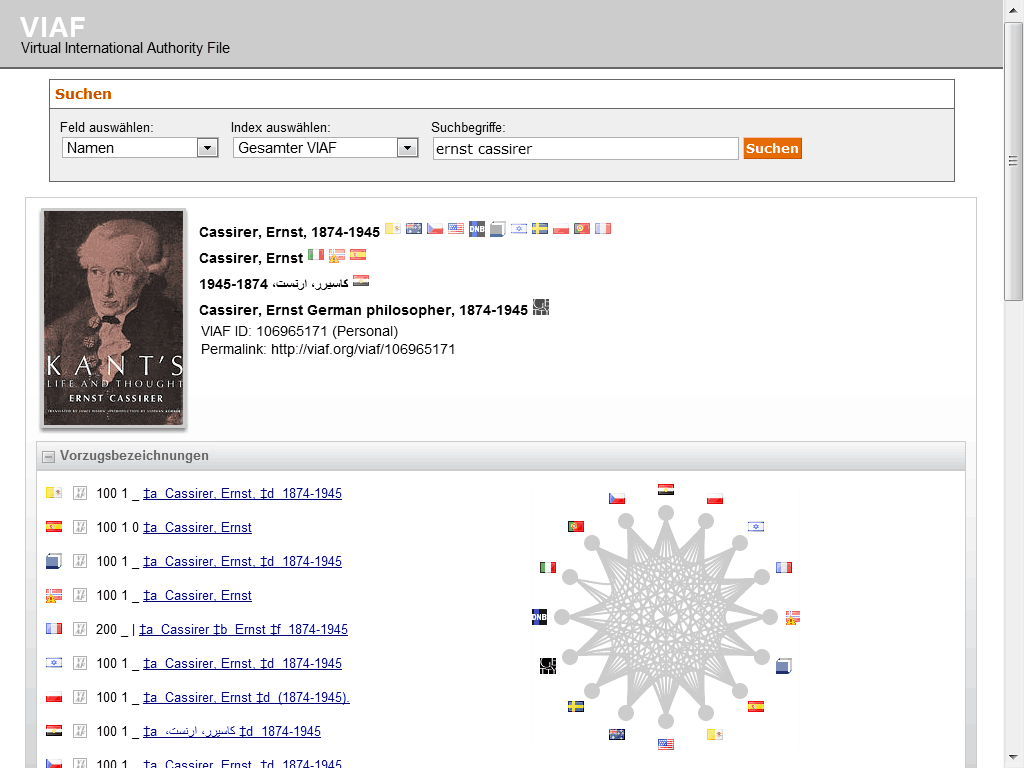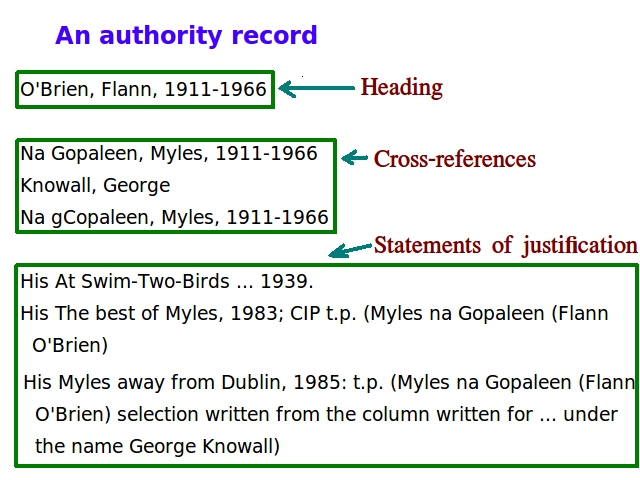|
Integrated Authority File
The (translated as ''Integrated Authority File'') or GND is an international authority file for the organisation of personal names, subject headings and corporate bodies from catalogues. It is used mainly for documentation in libraries and increasingly also by archives and museums. The GND is managed by the German National Library (; DNB) in cooperation with various regional library networks in German-speaking Europe and other partners. The GND falls under the Creative Commons Zero (CC0) licence. The GND specification provides a hierarchy of high-level entities and sub-classes, useful in library classification, and an approach to unambiguous identification of single elements. It also comprises an ontology intended for knowledge representation in the semantic web The Semantic Web, sometimes known as Web 3.0, is an extension of the World Wide Web through standards set by the World Wide Web Consortium (W3C). The goal of the Semantic Web is to make Internet data ma ... [...More Info...] [...Related Items...] OR: [Wikipedia] [Google] [Baidu] |
German National Library
The German National Library (DNB; ) is the central archival library and national bibliographic centre for the Federal Republic of Germany. It is one of the largest libraries in the world. Its task is to collect, permanently archive, comprehensively document and record bibliographically all German and German-language publications since 1913, foreign publications about Germany, translations of German works, and the works of German-speaking emigrants published abroad between 1933 and 1945, and to make them available to the public. The DNB is also responsible for the and several special collections like the (German Exile Archive), and the (German Museum of Books and Writing). The German National Library maintains co-operative external relations on a national and international level. For example, it is the leading partner in developing and maintaining bibliographic rules and standards in Germany and plays a significant role in the development of international library standards. ... [...More Info...] [...Related Items...] OR: [Wikipedia] [Google] [Baidu] |
Semantic Web
The Semantic Web, sometimes known as Web 3.0, is an extension of the World Wide Web through standards set by the World Wide Web Consortium (W3C). The goal of the Semantic Web is to make Internet data machine-readable. To enable the encoding of semantics with the data, technologies such as Resource Description Framework (RDF) and Web Ontology Language (OWL) are used. These technologies are used to formally represent metadata. For example, Ontology (information science), ontology can describe concepts, relationships between Entity–relationship model, entities, and categories of things. These embedded semantics offer significant advantages such as reasoning engine, reasoning over data and operating with heterogeneous data sources. These standards promote common data formats and exchange protocols on the Web, fundamentally the RDF. According to the W3C, "The Semantic Web provides a common framework that allows data to be shared and reused across application, enterprise, and commu ... [...More Info...] [...Related Items...] OR: [Wikipedia] [Google] [Baidu] |
Library Cataloging And Classification
A library is a collection of books, and possibly other materials and media, that is accessible for use by its members and members of allied institutions. Libraries provide physical (hard copies) or digital (soft copies) materials, and may be a physical location, a virtual space, or both. A library's collection normally includes printed materials which may be borrowed, and usually also includes a reference section of publications which may only be utilized inside the premises. Resources such as commercial releases of films, television programmes, other video recordings, radio, music and audio recordings may be available in many formats. These include DVDs, Blu-rays, CDs, cassettes, or other applicable formats such as microform. They may also provide access to information, music or other content held on bibliographic databases. In addition, some libraries offer creation stations for makers which offer access to a 3D printing station with a 3D scanner. Libraries can vary wid ... [...More Info...] [...Related Items...] OR: [Wikipedia] [Google] [Baidu] |
Virtual International Authority File
The Virtual International Authority File (VIAF) is an international authority file. It is a joint project of several national libraries, operated by the Online Computer Library Center (OCLC). History Discussions about having a joint international authority started in the late 1990s. After several failed attempts to develop a unique joint authority file, the new idea was to link existing national authorities. This would present all the benefits of a standard file without requiring a significant investment of time and expense in the process. The project was initiated by the American Library of Congress (LOC), the German National Library (DNB), and the OCLC in April 1998 as a proof-of-concept that authority records can be linked. After extensive testing, the VIAF consortium was formed at the 2003 World Library and Information Congress, hosted by the International Federation of Library Associations. on 6 August 2003, and by September it had its own page at the OCLC website. ... [...More Info...] [...Related Items...] OR: [Wikipedia] [Google] [Baidu] |
Schlagwortnormdatei
The or SWD (translated as ''Subject Headings Authority File'') is a controlled vocabulary index term system used primarily for subject indexing in library catalogs. The SWD is managed by the German National Library (DNB) in cooperation with various library networks. The inclusion of keywords in the SWD is defined by (RSWK) (English: Rules for the keyword catalogue). Similar authority systems in other languages include the Library of Congress Subject Headings (LCSH) and the (). Since April 2012 the SWD is part of the (GND) (English: Integrated Authority File). Scope The SWD has about 600,000 descriptors and 700,000 non-descriptors (synonyms and quasi-synonyms) as well as synonymous descriptor chains with references to a descriptor. Its growth rate is about 5.5% per year. About three-quarters of the descriptors refer to individual concepts (language identifier, person, entity, title, ethnography etc.) and a quarter are abstract concepts. Linking using hierarchical (about 115 ... [...More Info...] [...Related Items...] OR: [Wikipedia] [Google] [Baidu] |
Gemeinsame Körperschaftsdatei
The or GKD (translated as ''Corporate Bodies Authority File'') is a German authority control for the organisation of corporation names (corporate bodies) from catalogues. It is used mainly for documentation in libraries. Like the (SWD) (English: Subject Headings Authority File) and the (PND) (English: Name Authority File), the GKD is looked after and updated by the German National Library (DNB), the Bavarian State Library, the Berlin State Library and, since 1997, the Austrian National Library, several library networks taking part. The responsible editor is the State Library in Berlin. The GKD was created in the 1970s from the catalogue data of the (ZDB). In April 2004, it contained more than 915,000 records. Since April 2012 GKD, SWD and PND are part of the (GND) (English: Integrated Authority File). Structure As with the SWD and PND, the (RAK or RAK-WB) are used. They stipulate, amongst other things, what counts as a corporation. These include, ''inter alia'', local a ... [...More Info...] [...Related Items...] OR: [Wikipedia] [Google] [Baidu] |
Personennamendatei
The or PND (translated as ''Name Authority File'') is an authority file of people, which served primarily to access literature in libraries. The PND has been built up between 1995 and 1998 and was published by the German National Library (DNB) until 2012. For each person, there is a record with his or her name, birth and occupation connected with a unique identifier, the PND number. The PND comprises more than two million entries and is comparable with the Library of Congress Name Authority File (LCNAF). Since April 2012, the PND (which have since been discontinued) is part of the ' (GND) (aka ''Integrated Authority File''). For the exchange of name records, there is a separate machine exchange format for libraries called MAB-PND. See also * Library of Congress The Library of Congress (LOC) is a research library in Washington, D.C., serving as the library and research service for the United States Congress and the ''de facto'' national library of the United States. It al ... [...More Info...] [...Related Items...] OR: [Wikipedia] [Google] [Baidu] |
Resource Description Framework
The Resource Description Framework (RDF) is a method to describe and exchange graph data. It was originally designed as a data model for metadata by the World Wide Web Consortium (W3C). It provides a variety of syntax notations and formats, of which the most widely used is Turtle ( Terse RDF Triple Language). RDF is a directed graph composed of triple statements. An RDF graph statement is represented by: (1) a node for the subject, (2) an arc from subject to object, representing a predicate, and (3) a node for the object. Each of these parts can be identified by a Uniform Resource Identifier (URI). An object can also be a literal value. This simple, flexible data model has a lot of expressive power to represent complex situations, relationships, and other things of interest, while also being appropriately abstract. RDF was adopted as a W3C recommendation in 1999. The RDF 1.0 specification was published in 2004, and the RDF 1.1 specification in 2014. SPARQL is a standard query ... [...More Info...] [...Related Items...] OR: [Wikipedia] [Google] [Baidu] |
Knowledge Representation
Knowledge representation (KR) aims to model information in a structured manner to formally represent it as knowledge in knowledge-based systems whereas knowledge representation and reasoning (KRR, KR&R, or KR²) also aims to understand, reason, and interpret knowledge. KRR is widely used in the field of artificial intelligence (AI) with the goal to represent information about the world in a form that a computer system can use to solve complex tasks, such as diagnosing a medical condition or having a natural-language dialog. KR incorporates findings from psychology about how humans solve problems and represent knowledge, in order to design formalisms that make complex systems easier to design and build. KRR also incorporates findings from logic to automate various kinds of ''reasoning''. Traditional KRR focuses more on the declarative representation of knowledge. Related knowledge representation formalisms mainly include vocabularies, thesaurus, semantic networks, axiom system ... [...More Info...] [...Related Items...] OR: [Wikipedia] [Google] [Baidu] |
Authority File
In information science, authority control is a process that organizes information, for example in library catalogs, by using a single, distinct spelling of a name (heading) or an identifier (generally Persistent identifier, persistent and Alphanumericals, alphanumeric) for each topic or concept. The word ''authority'' in ''authority control'' derives from the idea that the names of people, places, things, and concepts are ''authorized,'' i.e., they are established in one particular form. Note: root words for both ''author'' and ''authority'' are words such as ''auctor'' or ''autor'' and ''autorite'' from the 13th century. These one-of-a-kind headings or identifiers are applied consistently throughout catalogs which make use of the respective authority file, and are applied for other methods of organizing data such as linkages and Cross-reference, cross references. Each controlled entry is described in an authority ''record'' in terms of its scope and usage, and this organization ... [...More Info...] [...Related Items...] OR: [Wikipedia] [Google] [Baidu] |
Ontology (computer Science)
In information science, an ontology encompasses a representation, formal naming, and definitions of the categories, properties, and relations between the concepts, data, or entities that pertain to one, many, or all domains of discourse. More simply, an ontology is a way of showing the properties of a subject area and how they are related, by defining a set of terms and relational expressions that represent the entities in that subject area. The field which studies ontologies so conceived is sometimes referred to as ''applied ontology''. Every academic discipline or field, in creating its terminology, thereby lays the groundwork for an ontology. Each uses ontological assumptions to frame explicit theories, research and applications. Improved ontologies may improve problem solving within that domain, interoperability of data systems, and discoverability of data. Translating research papers within every field is a problem made easier when experts from different countries mainta ... [...More Info...] [...Related Items...] OR: [Wikipedia] [Google] [Baidu] |





